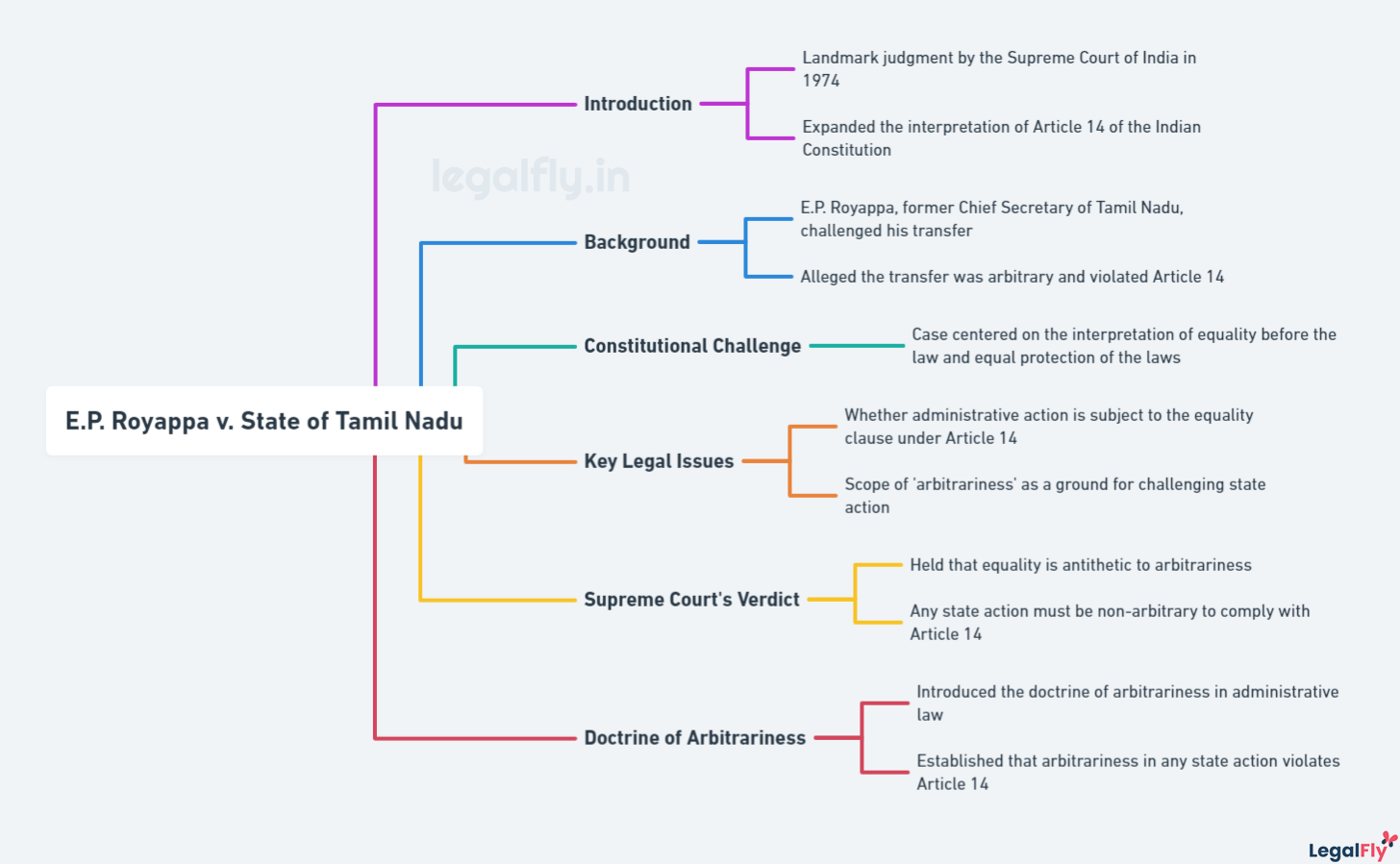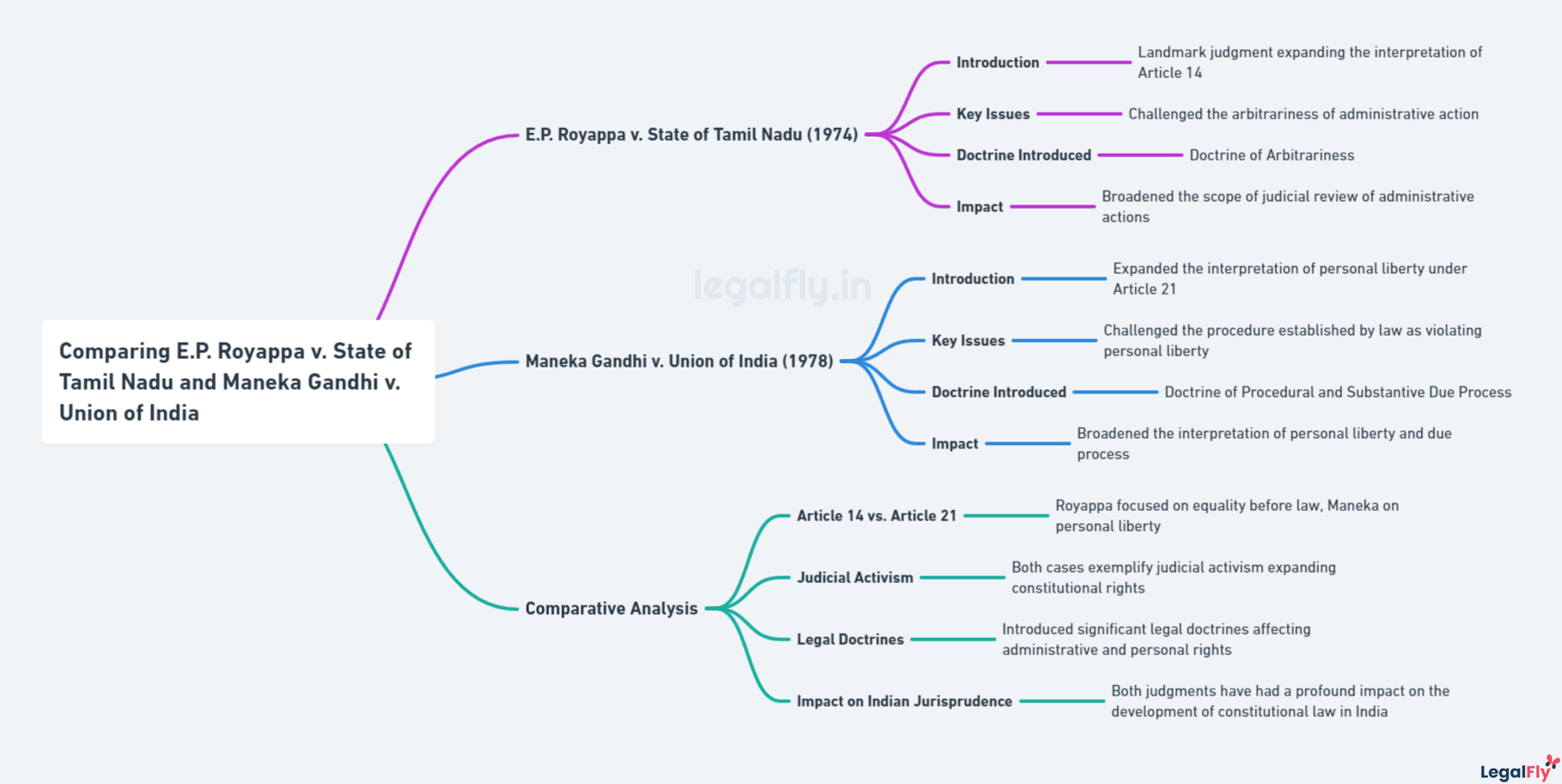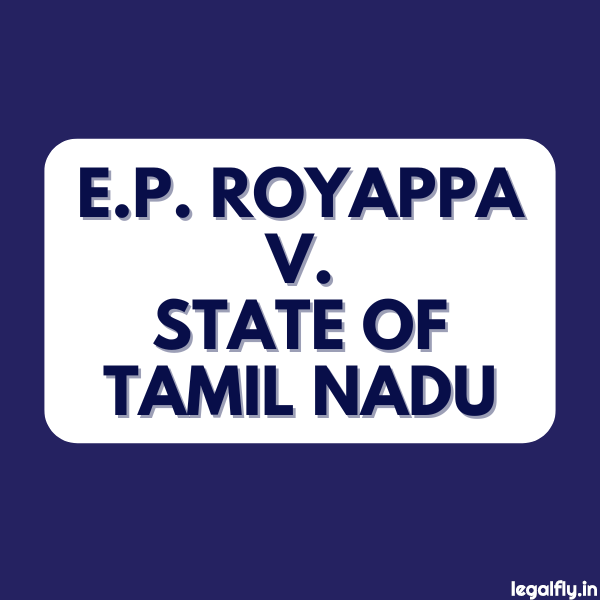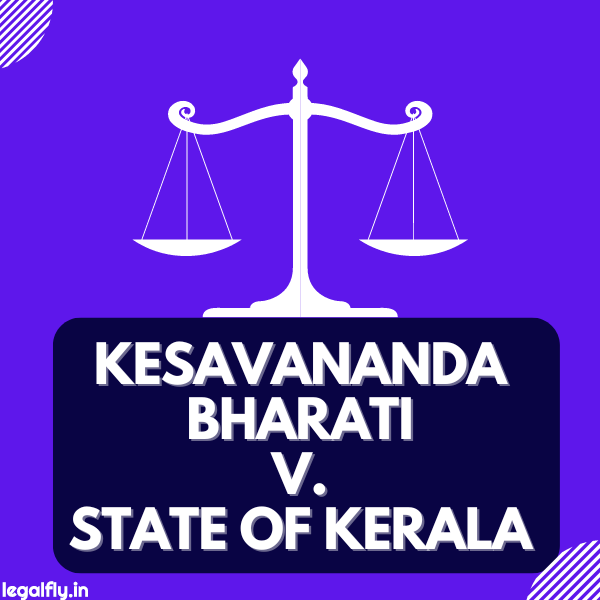Case Name: E.P. Royappa vs State Of Tamil Nadu & Anr
Court: Supreme Court of India
Year: 1973
Citation: 1974 AIR 555, 1974 SCR (2) 348
Table of Contents
Introduction to E.P. Royappa v. State of Tamil Nadu
E.P. Royappa v. State of Tamil Nadu is a landmark case in Indian constitutional law that expanded the scope of Article 14 and established the principle of equality and non-arbitrariness in state action. The case was decided by a Constitutional Bench of the Supreme Court in 1974 and has had a lasting impact on administrative law and jurisprudence in India.
The case arose in the context of a supersession in the appointment of a Chief Secretary in the state civil services of Tamil Nadu. E.P. Royappa, who was serving as Acting Chief Secretary, was overlooked for appointment as permanent Chief Secretary in favour of a junior officer. Royappa challenged this as arbitrary, unequal treatment and a violation of his rights under Articles 14, 16, and 311 of the Constitution.
At the time, Article 14 had been interpreted narrowly by courts to mean only equality before the law and equal protection of laws. There was no established principle to check arbitrary state action. Through this case, the Supreme Court expanded Article 14 to include a prohibition on arbitrariness, laying the foundations of a new era in Indian administrative law. The case marked a significant shift in the Court’s interpretation of equality under the Constitution.
The case gained national prominence and highlighted the significance of equality as a constitutional value. It exemplified the Supreme Court’s role in advancing and upholding fundamental rights. E.P. Royappa v. State of Tamil Nadu is considered one of the Court’s most crucial Article 14 decisions and a landmark constitutional precedent.
Background of the Case
The case arose from the dismissal of E.P. Royappa from service in the Indian Administrative Service (IAS) cadre of the State of Tamil Nadu. Royappa was serving as Additional Chief Secretary in the state government when the new Chief Minister took office in 1969. In November of that year, Royappa was abruptly transferred from his post and appointed as Chairman of the State Textbook Committee, which was seen as a demotion. Two months later, in January 1970, his services were terminated without notice or inquiry.

Royappa challenged his dismissal by filing writ petitions in the Madras High Court and the Supreme Court. The High Court upheld the government’s decision, stating that no reasons needed to be provided for terminating the services of a probationer. Royappa then appealed to the Supreme Court, which admitted the case for hearing. The key issues raised were related to equality under Article 14 and arbitrariness in state action.
Key Legal Issues Raised
The primary legal issues raised in E.P. Royappa v. State of Tamil Nadu were related to equality, arbitrariness and the scope of judicial review under Article 14 of the Constitution.
The main questions before the Supreme Court were:
- Whether the State’s administrative decision to compulsorily retire the petitioner from service was arbitrary and violated his right to equality under Article 14.
- Whether Article 14 only prohibits discrimination and not arbitrariness in State action.
- Whether the scope of judicial review should extend to examining the arbitrariness of administrative decisions under Article 14.
- How should the concepts of equality and arbitrariness be interpreted under Article 14 and applied to administrative actions?
The case required the Supreme Court to analyze the scope and meaning of the right to equality under Article 14 in relation to arbitrary State action. It raised important questions about how the fundamental right to equality is interpreted as it evolves.
The Supreme Court’s Landmark Judgment
The Supreme Court’s judgment in E.P. Royappa v. State of Tamil Nadu is considered a landmark ruling that expanded the scope of Article 14 of the Constitution. The case was heard by a five-judge bench, with the majority opinion authored by Justice P.N. Bhagwati.
Justice Bhagwati’s reasoning significantly broadened the interpretation of Article 14 beyond the traditional classification test. He stated that equality is a dynamic concept with many facets and that the doctrine of classification should not be confined to a narrow view of permissible and forbidden classifications.
The Court held that Article 14 forbids arbitrariness in state legislation and executive action. This established the principle that state action must not be arbitrary and must follow a rational standard that withstands the test of Article 14.
The Court enabled judicial review of administrative decisions by expanding Article 14 to prohibit arbitrary state action. This case established the arbitrariness standard under Article 14, strengthening the constitutional protection of equality before the law.
Analysis of the Court’s Reasoning
The Supreme Court significantly expanded the scope of equality under Article 14 in its judgment in E.P. Royappa v. State of Tamil Nadu. The Court held that equality is a dynamic concept and that any arbitrary state action violates Article 14. This reasoning broadened the application of Article 14 beyond just ensuring equality before the law and non-discrimination.
The Court also imposed limitations on the discretionary powers of the executive and administration. It ruled that administrative authorities must exercise their discretion reasonably, non-arbitrarily, and in a non-discriminatory manner. This placed checks on arbitrary state action. The E.P. Royappa judgment thus had significant implications for limiting the misuse of administrative discretion and establishing the rule of reason and non-arbitrariness in state action.
The Impact of E.P. Royappa
The judgment in E.P. Royappa has profoundly influenced Indian jurisprudence and the development of administrative law in the decades since it was decided. One of the most significant impacts was strengthening the scope of judicial review of administrative action. The Court asserted its power to strike down arbitrary state action as unconstitutional based on the expanded interpretation of Article 14. This paved the way for more active scrutiny of executive decisions.
E.P. Royappa also reinforced the concept of due process in administrative law, requiring the government to act fairly and reasonably. The judgment has been frequently cited in subsequent cases dealing with equality and non-arbitrariness as an essential constitutional limitation on the exercise of state power. It established broad principles of good governance that remain highly relevant today.
Overall, E.P. Royappa strengthened judicial authority to check the potential misuse of discretion by the executive branch of government. Expanding the horizons of Article 14 empowered courts to protect better civil liberties and the rule of law in India. The verdict demonstrated the Supreme Court’s determination to uphold constitutional morality against unjust state actions.
Critical Perspectives on the Judgment
The E.P. Royappa judgment has been extensively analyzed and critiqued by legal scholars. Some have praised the expansion of Article 14, while others argue it went too far.
One debate centers around the Court’s arbitrariness standard. As K.K. Venugopal notes, the ruling “throws open a vast field for the court to strike down any and every administrative action which does not appeal to its sense of propriety or wisdom.” This gives the judiciary significant power over the executive and legislature. However, Upendra Baxi argues arbitrariness was necessary to check potential abuses. The key is developing precise guidelines on when action is arbitrary.
Overall, E.P. Royappa represented a major shift in Indian constitutional law. While the debate continues, its influence is undisputed. The judgment expanded judicial review and strengthened protections against discrimination.
Comparison with Maneka Gandhi v. Union of India
The E.P. Royappa judgment has often been compared to the landmark Maneka Gandhi v. Union of India case decided by the Supreme Court a few years later in 1978. Both cases significantly expanded the scope and interpretation of Article 14 and the right to equality under the Constitution.

However, there are some critical differences between the two cases.
| Aspect | E.P. Royappa vs. State of Tamil Nadu | Maneka Gandhi vs. Union of India |
|---|---|---|
| Key Contribution | Introduced the concept of arbitrariness as a form of discrimination prohibited under Article 14. | Built upon the concept of arbitrariness by linking Article 14 with Article 21, establishing that laws restricting fundamental rights under Article 21 must be fair, just, reasonable, and not arbitrary. |
| Preceding Legal Test | Before this case, the courts used a narrow ‘classification test’ under Article 14, focusing on irrational classifications or discrimination without adequate justification. | E.P. Royappa’s expansion of Article 14 was the backdrop, with a focus on broadening the interpretation of fundamental rights. |
| Legal Expansion | Expanded Article 14 beyond the classification rule to include arbitrariness as a ground for challenging laws. | It went further than E.P. Royappa by requiring that restrictions on fundamental rights also satisfy substantive due process under Article 21. |
| Impact on Fundamental Rights | Marked a significant shift in judicial attitude towards a broader interpretation of Article 14. | Represented a further shift towards adopting a broad and liberal interpretation of fundamental rights and limitations on state power, linking due process with Article 14. |
| Judicial Attitude | Signalled a shifting judicial attitude towards a more liberal interpretation of fundamental rights. | Continued and developed the shift towards a broad and liberal interpretation of fundamental rights, emphasizing the importance of due process. |
Conclusion and Key Takeaways
The landmark Supreme Court judgment in E.P. Royappa v. State of Tamil Nadu has had a lasting impact on Indian constitutional law and jurisprudence. This case expanded the scope of Article 14 and established the principle that equality is violated when a public authority acts arbitrarily.
The judgment made several significant contributions:
- Established that arbitrariness in state action is antithetical to equality before law under Article 14, expanding the interpretation to bring a wider range of administrative actions under judicial review.
- Ruled that Article 14 applies to both legislative and executive actions, thereby increasing accountability.
- Focused on the effect of state action rather than just its form or intention, advocating for a substantive approach that better upholds citizens’ fundamental rights.
- Strengthened procedural due process requirements for the government when taking adverse action against individuals.




